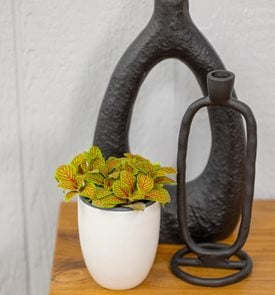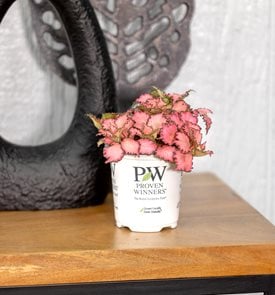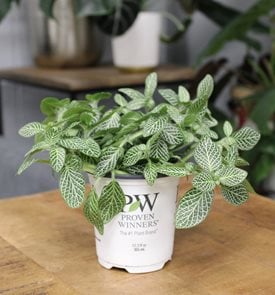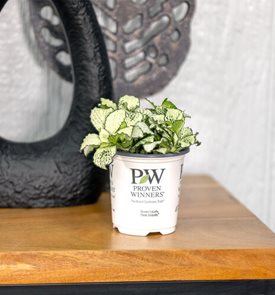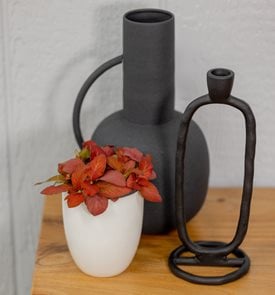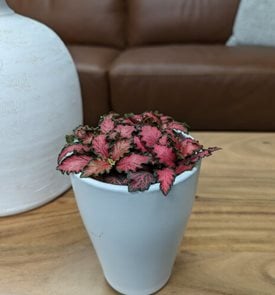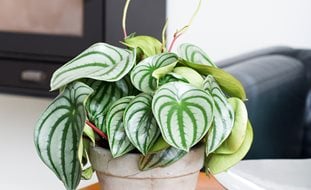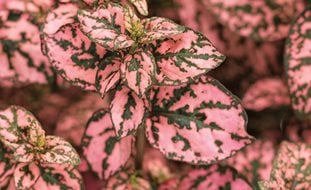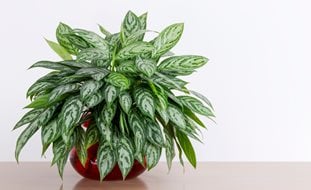How to Grow Nerve Plant (Fittonia)
Get planting and care tips for growing this captivating tropical houseplant.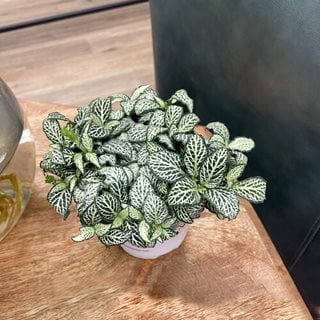
Network News™ World Views™ nerve plant. Photo by: Proven Winners
With its colorful, intricately veined leaves, nerve plant (Fittonia albivenis) is one of the most distinctive houseplants around and a favorite of many indoor plant connoisseurs. Rarely growing more than 8 inches tall, this dainty beauty is perfect for displaying on desks and tabletops or tucking into terrariums and dish gardens. While most nerve plants have dark green leaves with contrasting veins in pink or white, you can also find head-turning cultivars with lime green, pink, or white leaves and veins in colors ranging from crimson red to purple.
Before succumbing to the charms of nerve plant and bringing one into your home, be aware that it will require a bit more pampering than some other houseplants, like the easy-going spider plant or snake plant. But if you’re willing to give it the extra attention it deserves, you’ll be rewarded with a beautiful addition to your indoor plant collection.
On this page: Basics | Growing Tips | Care | Varieties | Common Problems
On this page:
- NERVE PLANT BASICS
- GROWING NERVE PLANTS
- NERVE PLANT CARE
- NERVE PLANT VARIETIES
- TROUBLESHOOTING COMMON PROBLEMS
BASICS
Botanical name:
Fittonia albivenis
Common names:
Nerve plant, fittonia, mosaic plant, painted net leaf plant (all nicknames inspired by the veined pattern of the foliage)
Origin:
Native to the tropical rainforests of South America
Care level:
Moderate
Light requirements:
Bright, indirect light
Size:
3 to 8 inches tall, with a slowly spreading growth habit
Special attributes:
- Non-toxic and pet friendly
- Improves indoor air quality by filtering out impurities
- One of the best houseplants for terrariums
Does nerve plant flower?
Under ideal conditions, Fittonia may occasionally produce short spikes of creamy white flowers. Most people snip off the blooms as soon as they appear because they are small and insignificant and take a lot of energy away from foliage production.
GROWING NERVE PLANTS
Where to grow:
Fittonia performs best in bright indirect light, such as within a few feet of an east-, west-, or even north-facing window. It also grows well under fluorescent lighting or grow lights. Avoid exposing to direct midday sun, which can scorch the leaves, or giving your plant too little light, which can result in spindly growth and a loss of color intensity.
Temperature and humidity:
Nerve plants thrive in a warm and humid environment, like they are accustomed to in their native tropical habitat. Fittonia prefer temperatures ranging from 60° to 85° F and humidity levels of 50% or higher. You can recreate this environment in your home by growing your nerve plants in a terrarium, a steamy bathroom, or on a gravel tray filled with water. Avoid exposing plants to cold drafts or sudden temperature fluctuations. (See more houseplants that like high humidity.)
Soil type:
Use a well-draining potting mix with some perlite or orchid bark added to improve drainage and aeration.
Pot requirements:
Plant in a pot about 1 to 2 inches wider than the root ball, with drainage holes to help prevent root rot. Because of their creeping growth habit and shallow roots, nerve plants are perfect for dish gardens and other wide, shallow containers.
Can you grow nerve plants outdoors?
If you live in zones 11-12, where nerve plant is an evergreen perennial, you can grow it outdoors in a shady location as a creeping ground cover, as long as you can provide the consistent moisture it needs to thrive. Because nerve plant is extremely sensitive to cold temperatures, it should only be grown indoors in cooler climates.
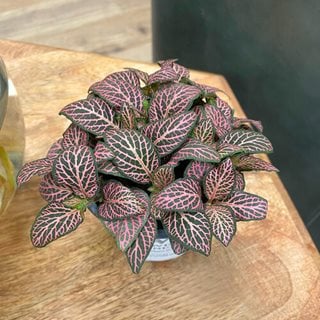
Network News™ Daytime™ nerve plant. Photo by: Proven Winners
NERVE PLANT CARE
Watering:
Consistency is key when it comes to watering a nerve plant. You shouldn’t let the soil dry out completely or become oversaturated. A good rule of thumb is to water when the top inch of soil is dry, allowing the water to drain out the bottom of the pot. Never let your plant sit in standing water, which can result in soggy soil and root rot.
Fertilizing:
Fertilize your nerve plant once a month with a general houseplant fertilizer diluted to half strength. Apply less frequently during the winter months, when plant growth slows.
Pruning:
If you want to keep your fittonia compact and bushy, prune back the stems on occasion to maintain the desired shape, cutting just above a leaf node. Also remove any flower spikes that appear to keep the foliage full and healthy.
Repotting:
Repot your nerve plant every two or three years, or whenever you see the roots begin to grow out of the pot’s drainage holes. The best time to repot is in spring, when plants emerge from semi-dormancy. Choose a new container 2 inches wider in diameter than the current one, and fill it with fresh potting mix before transplanting.
Propagation:
As they spread, the creeping stems of fittonias will naturally put out roots that will grow into the surrounding soil. You can remove these rooted sections to start new plants or you can propagate your plant by taking cuttings from the stem tips, just below a leaf node. (*See note below on propagating patented plants—check your plant tags for ® or ™ symbols next to the plant name).
Pests and diseases:
Be on the lookout out for common houseplant pests, such as aphids, thrips, mealybugs, and spider mites.
NERVE PLANT VARIETIES
TROUBLESHOOTING COMMON PROBLEMS: NERVE PLANTS
Nerve plants are very finicky about their growing conditions and will let you know when they are unhappy in their environment. Here are the most common problems to watch out for and tips for restoring an ailing plant to health.
- Wilted, limp leaves: A telltale sign that your plant is thirsty. Usually the leaves will revive quickly after you give your plant a good soaking. To avoid stressing out your plant too often, it’s best to keep to a regular watering schedule.
- Yellowing leaves: Usually due to overwatering, and often the first sign that root rot may be occurring. Cut back on your watering frequency, and make sure the base of your pot is not sitting in excess water. If the soil has become soggy, you may need to repot your plant in fresh potting mix.
- Dry, browning leaves: Low humidity and too much exposure to direct sunlight are the likely causes of leaf tips and edges turning brown. Move your plant to an area away from direct midday sun, and mist the leaves daily to help boost the humidity.
- Spindly or leggy growth: Often caused by a lack of sunlight. If you don't have a spot available with brighter light, try placing your nerve plant under grow lights. Pinching off the leggy growth will encourage a fuller, bushier shape.
- Dropping leaves: A number of factors can lead to leaf drop, including underwatering, temperature fluctuations, and exposure to drafts. Keep your fittonia away from heating and cooling vents and at a comfortable room temperature above 65° F.
*REGARDING PROPAGATION: When it comes to propagating patented plants, there are strict rules in place prohibiting reproduction or propagation of these plants in any way. This means you can't reproduce them (even for use in your own garden), sell them, or bring them into the country without permission. The law does not make exceptions for what some might consider minor infringements. Any unauthorized use of patented plants is considered an infringement.
